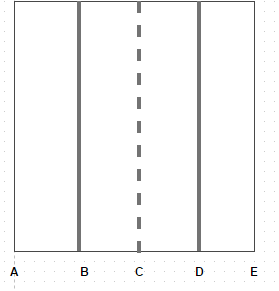This set of Heat Transfer Multiple Choice Questions & Answers (MCQs) focuses on “Heat Generation Through Cylinder”.
1. A 25 mm diameter egg roll (k = 1 W/m degree) is roasted with the help of microwave heating. For good quality roasting, it is desired that temperature at the center of roll is maintained at 100 degree Celsius when the surrounding temperature is 25 degree Celsius. What should be the heating capacity in W/m 3 of the microwave if the heat transfer coefficient on the surface of egg roll is 20 W/m2 degree?
a) 113.31 k W/m3
b) 213.31 k W/m3
c) 313.31 k W/m3
d) 413.31 k W/m3
View Answer
Explanation: t max = t a + q g R/2h + q g R2/4k.
2. The constants of integration are to be determined from the relevant boundary conditions which are
(i) t = t w at r = R
(ii) q g (π L R2) = -k (2 π R L) (d t/d r)
(iii) Increasing temperature gradient
Choose the correct option?
a) Only i
b) Only ii
c) i and iii
d) i and ii
View Answer
Explanation: Temperature gradient must be constant.
3. A concrete column used in bridge construction is cylindrical in shape with a diameter of 1 meter. The column is completely poured in a short interval of time and the hydration of concrete results in the equivalent of a uniform source strength of 0.7 W/kg. Determine the temperature at the center of the cylinder at a time when the outside surface temperature is 75 degree Celsius. The column is sufficiently long so that temperature variation along its length may be neglected. For concrete
Average thermal conductivity = 0.95 W/m K
Average density = 2300 kg/m3
a) 190.92 degree Celsius
b) 180.92 degree Celsius
c) 170.92 degree Celsius
d) 160.92 degree Celsius
View Answer
Explanation: t max = t w + q g R2/4k. We get, q g = 0.7 W/kg.
4. The temperature distribution profile for a solid cylinder is
a) Parabolic
b) Linear
c) Ellipse
d) Hyperbolic
View Answer
Explanation: It must be parabolic for maximum heat conduction.
5. For a solid cylinder, maximum temperature difference occurring at the center of the rod is given by
a) t W – q g R2/4K
b) q g R2/4K
c) t W + q g R2/4K
d) t W + q g R2/4KL
View Answer
Explanation: As temperature distribution profile is parabolic so on integrating between boundary conditions we get the result.
6. A slab of 12 cm thickness and generating heat uniformly at 10 6 W/m3 has thermal conductivity of 200 W/m degree. Both surfaces of the slab are maintained at 150 degree Celsius. Determine the heat flow rate at the quarter planes

a) 30000 W/m2
b) 40000 W/m2
c) 50000 W/m2
d) 60000 W/m2
View Answer
Explanation: q g (π R2 L) = (t w – t a) (2 π R L) h.
7. Consider a convective heat flow to water at 75 degree Celsius from a cylindrical nuclear reactor fuel rod of 50 mm diameter. The rate of heat generatioN is 50000000 W/m3 and convective heat transfer coefficient is I kW/m2 K. The outer surface temperature of the fuel element would be
a) 625 degree Celsius
b) 700 degree Celsius
c) 550 degree Celsius
d) 400 degree Celsius
View Answer
Explanation: t w = t a + q g R/ 2h.
8. For a cylindrical rod with uniformly distributed heat sources, the thermal gradient at half the radius location will be
a) Four times
b) Twice
c) One fourth
d) One half
View Answer
Explanation: t = t w + q g (R2 – r2)/4k. (d t /d r) r = R/2 = 1/2(d t/d r) r = R.
9. The maximum temperature for cylindrical coordinate occurring at r = 0 is
a) t max = t a +q g R/h + q g R2/4k
b) t max = t a +q g R/4h + q g R2/4k
c) t max = t a +q g R/2h + q g R2/4k
d) t max = t a +q g R/6h + q g R2/4k
View Answer
Explanation: As, t = t a +q g R/6h + q g R2/4k (R2 –r2).
10. In case of solid cylinder of radius R, the temperature distribution is given as
a) t – t w/t max – t w = 1 – (r/R)2
b) t – t w/t max – t w = 1 – (r/R)
c) t – t w/t max – t w = 1 – (r/R)3
d) t – t w/t max – t w = 1 – (r/R)4
View Answer
Explanation: As we know for a long cylinder of radius R, t = t w + q g (R2 – r2)/4k. On integrating this we get the answer. Where, t w is outer surface temperature and t max is along cylinder axis.
Sanfoundry Global Education & Learning Series – Heat Transfer.
To practice all areas of Heat Transfer, here is complete set of 1000+ Multiple Choice Questions and Answers.
If you find a mistake in question / option / answer, kindly take a screenshot and email to [email protected]
- Check Chemical Engineering Books
- Apply for Chemical Engineering Internship
- Practice Chemical Engineering MCQs
- Check Heat Transfer Books
- Practice Mechanical Engineering MCQs
